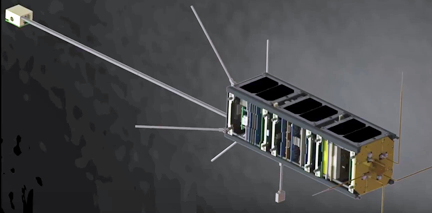
The University of Alberta's online infosite is reporting that a team of students from the university will be propelling the province into the space industry by launching the first ever made-in-Alberta satellite next week from Cape Canaveral.
Ex-Alta 1, the U of A AlbertaSat team’s satellite, will examine space weather to better understand the powerful forces that pose a threat to spacecraft and other satellites as well as vital power and electronic networks on Earth, said Ian Mann, a professor of space physics at the U of A.
The launch will be streamed via NASA Live and United Launch Alliance.
For example, in 1989, a massive solar flare caused geomagnetic storms that knocked out power to some six million Hydro Quebec customers. It could have been much worse; if Earth were to experience a severe event—such as the biggest solar flare recorded in history in 1859—the cost of restoring our power and communications infrastructure has been estimated in the trillions of dollars in North America alone.
“There is no strategy to prevent solar flares, but we can be better prepared to protect ourselves,” said electrical engineering professor Duncan Elliott, who supervised the team along with Mann and a handful of U of A academics. “We need to understand the potential damage and the causes and find ways to mitigate the impact of space weather. [This] mission will help us do that.”

Artistic rendition of the ExAlta-1 smallsat.
Image is courtesy of the University of Alberta.
Ex-Alta 1 is part of a newer generation of technologies that puts space exploration and research within reach of students and smaller startup companies. It’s a cube satellite (cubesat), no bigger than a loaf of bread. The availability of technology combined with the experience team members have had is opening the door to economic diversification in Alberta. A group of senior students has created its own spinoff company, Promethean Labs. Described as a “space information company,” Promethean offers space expertise to clients from government and industry to monitor agricultural, mining or forestry industry activities, and can monitor pollutants or natural phenomena.
Ex-Alta 1 is part of the international QB50 mission, which comprises about 50 smallsats built at universities around the world. Mann and Elliott said they’re deeply impressed with the achievements of their students—most of whom are undergraduates. Of 50 universities originally participating in the QB50 mission, the U of A is the only one whose contingent is led and primarily staffed by undergraduate students.
“These students are working at a tremendous capacity,” Elliott said. “They are not only gaining a tremendous amount of technical knowledge, they’re also learning a lot about project management. Our satellite was among the first 10 completed, shipped and integrated with other satellites, so we have certainly shown up. We’ve been ahead of the game.”
The satellites will make a brief pit stop aboard the International Space Station before making their final journey into LEOto begin monitoring space weather.

